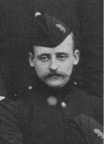Major Charles Edward Pollock
DSO (1917) CB (1921) CBE (1919) MRCS LRCP
25 Apr 1868 [Paisley] – 18 May 1929
Major Charles Edward Pollocke was the son of A R Pollock of Greenhill, Paisley, JP for the county of Renfrew. He was educated at Wellington College and Guy's Hospital London.
On 24 February 1904, Lord Esher's Committee recommended the attachment of an RAMC office to the Directorate of Military Operations which dealt with military intelligence so as to learn form the medical organisation of foreign armies. Major Pollock was the second officer to be appointed and took over from Lt Col Macpherson William Grant.
Service Record

30 Jan 1893 Surgeon-Lieutenant.
30 Jan 1896 Appointed Surgeon-Captain.
1897–1898 Served on the North West Frontier British India. Took part in operations on the North West Frontier of India, with the Tirah Expeditionary Force. Received a medal with two clasps.
11 Oct 1899–31 May 1902 Served in the Anglo–Boer War, South Africa. Received the Queen's Medal with two clasps.
Jan 1904 Started a six month tour of the principal European Hospitals to study the most recent treatments of venereal diseases.
30 July 1904 Promoted Major RAMC. Passed his examination for promotion for the rank of Major in Oct 1903. He was awarded a 2nd Class certificate which made him eligible to six months acceleration in promotion.

Malta May 1905 Arrived from Woolwich as Sanitary Officer.
Malta July–Dec 1905 Officer in charge Military Hospital Cottonera. In 1905, Major Pollock introduced the irrigation treatment of gonorrhoea at the Cottonera Hospital. Soon after, this treatment was adopted by the other hospitals in Malta.
The urethra was irrigated twice a day, morning and evening, with the intention of getting rid of the gonococcus from the mucosa. Potassium permanganate 1 to 2 grains to the pint was mainly used, but silver nitrate 2 grains to the pint or albargin 2 to 5 grains to the pint were also used. When the discharge had ceased entirely and the urine remained clear for five successive mornings, the disease was assumed cured and the soldier returned to duty. If threads or mucus persisted in spite of every change of treatment, the soldier was ordered a pint of beer and 4 ounces of pickles daily for five days. If this failed to produce any increased turbidity or mucoid discharge the soldier was returned to duty and observed.
Maj Masters kept a number of these cases at Mtarfa, under observation while performing duty. In practically every case the urine cleared up in one to five weeks. All acute cases were kept in bed till their symptoms subsided. In the ordinary mildly acute case the patient was allowed up with his bed down, and the chronic cases were kept up from the start. All acute cases were placed on a milk diet with porridge and barley water till the scalding had ceased. They were then placed on an ordinary diet. During the acute stage, patients were treated with 5 grains of citrate of lithium and 10 grain of urotropin three times a day to relieve scalding.
In the subacute stage, balsam of copaiba, or sandal wood oil were prescribed. Benzoic Acid 15 grains three times a day was given when the urine was turbid but in Maj Pollock's experience, none of these drugs given orally were of any use. Potassium permanganate 1 to 2 grains to the pint, and silver nitrate 2 grains to the pint, or albargin 2 1/2 to 5 grains to the pint were also administered.
4 Jan 1906 At Felixstowe he married Winifred Mabel Jay, youngest daughter of C. E. H. Jay, late of the War Office, of Glenesk, Felixstowe.
Malta Feb 1906 In England on leave.
Malta May 1906 Specialist in Venereal Diseases and Dermatology.
Malta 18 Nov 1906 Baptism of Winifred Margaret Pollock, born on 19 October 1906, daughter of Winifred Mabel and Major Charles Edward Pollock resident at No 47 Strada Mezzodi (South Street) Valletta.
Malta Jan 1907 Specialist in Venereal Diseases and Dermatology at Valletta Military Hospital.
Malta June 1907 In England on leave.
Malta Jan 1908 Officer in charge Military Families Hospital Valletta.
Malta 28 Nov 1908 Baptism of Charles Bryan Russell Pollock, born on 25 October 1908.
Malta Aug 1909 In England on leave.
Specialist in VD and dermatology and anaesthetist.
Malta Nov 1909 Struck off the strength of the Malta Garrison. Posted to London. While in Malta Pollock was responsible for writing the Notes from Malta section of the Journal of the RAMC.
29 Dec 1909–28 Dec 1913 Deputy Assistant Director General attached to Department of the Director of Military Operations War Office.
23 Aug 1913 Birth of a daughter at 22 Normanton Road South Croydon.
29 Dec 1913 Replaced by Major John V Forrest MB, RAMC, as Deputy Assistant Director-General (attached to the Department of the Director of Military Operations at the War Office).
Feb 1914 Left London District for duty at Sierra Leone, as Senior Medical Officer West Africa, vice Lt Col J J Gerrard RAMC.
28 July 1914 Start of the Great War.
4 Aug 1914 Britain declares war on Germany.
1914 Served in the Great War.
1 Mar 1915 Promoted Lieutenant Colonel RAMC.
3 Nov 1915 Temporary Colonel whilst Assistant Director Medical Services of a Division.
1 Jan 1917 Was made a Companion of the Distinguished Service Order (DSO).
26 Dec 1917 Promoted Colonel L/RAMC.
Bibliography
- Entry No: 7385. Johnston W. 1917. Roll of Commissioned Officers in the Medical Service of the British Army. Vol I (20 June 1727 to 23 June 1898), Aberdeen, University Press.
- Distribution of RAMC Officers. Corps News Vol IV: 6; June 1905.
- Succession Books Vol XIX Returns of statement of service of RAMC Officers.
- Pollock C E, Remarks on the treatment of gonorrhoea in Malta. J R Army Med Corps (October 1909), Vol 13; 4: 375-383.
- O'Moore C., and Humphris E. M., The VC and DSO Vol III from 1 January 1916 to 12 June 1923.